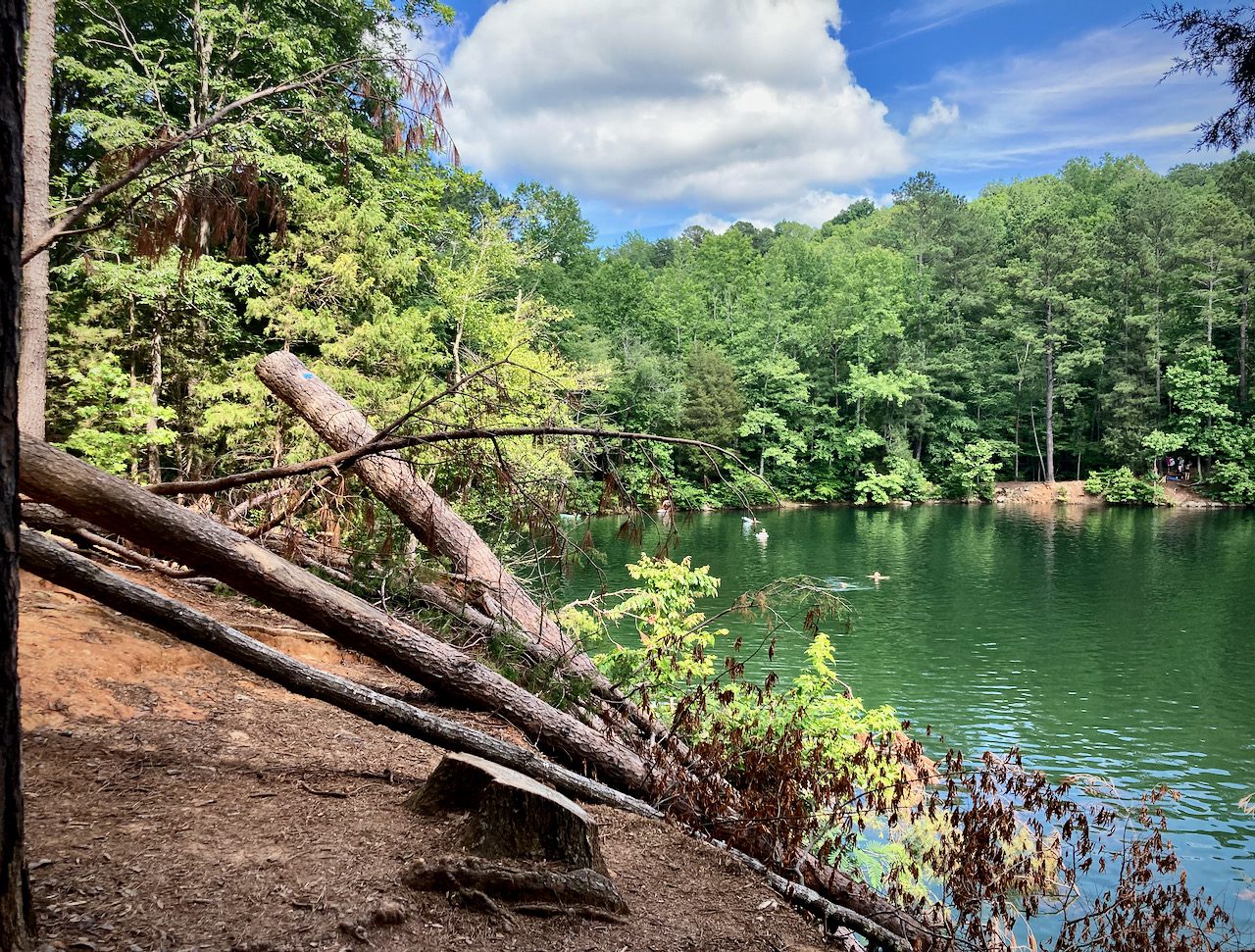Correction: This story has been updated to remove inaccurate information regarding past attempts to discourage swimming at the Eno River State Park quarry.
After a series of drownings and broken-bone injuries at an old rock quarry in the Eno River State Park — a beautiful swimming hole enjoyed by Durhamites since the 1970s — state park officials have taken action they hope will prevent future accidents.
This spring, they felled trees to create a barrier at a dangerous jumping spot — a cliff with a 25-foot drop into deep water.
While they hope to make the four-acre Eno Quarry a safer place to visit, they acknowledge that some visitors are upset about the change.
“I know that it makes people unhappy,” said Kimberly Radewicz, the Eno River State Park superintendent. “But the quarry needs to turn into a purely recreational area, not a hub for daredevils.”

Four swimmers have died since 1993 at the Eno Quarry, which Radewicz calls a “beautiful nuisance.” In recent years, her office has received calls about broken backs, broken feet and broken ankles. Three years ago, a 15-year-old girl broke four ribs and suffered a collapsed lung after jumping from the cliff and hitting a tree trunk on her way down.
The Eno Quarry is surrounded by steep banks in some areas and is uniformly around 65 feet deep. The view from its rocky ledges may give the illusion of a smooth landing, but just under the surface of the dark green water lies a treacherous mix of logs and debris. To enter the water, swimmers must either jump from a 12-to-25-foot rock shelf, climb down a rocky bank, or wade in through the only shallow area — where the bottom is riddled with debris and sharp rocks.
On her routine patrols, Radewicz warns visitors of the quarry’s hidden dangers.

“I tell them the quarry is beautiful, but there’s these other things you need to know for your own protection, for your own security and safety.”
Visitors frequently do not realize how deep the swimming hole actually is, and that there are no lifeguards, Radewicz said. After she shares her insights and statistics, they sometimes reconsider their plans to jump or swim without life vests or rafts.
The Eno Quarry was excavated in the 1960s to provide stone for the construction of nearby Interstate 85. In later years it filled in naturally with water, and visitors soon followed.
The quarry was originally on private property, and locals would trespass to swim, fish, or cliff jump. When people started to get hurt, the property owners at the time, the Coile family, took action.
“They put up barbed wire, they put up barriers, and people would tear them down,” said Radewicz. “It was a very popular place for people to go. I’ve heard stories that they hired a guy with a .22 rifle to try to keep people away.”

For 29-year-old Durham native Todd Fox, the Eno Quarry and its infamous jump have been a reliable weekend destination for more than 13 years. In fact, Fox’s parents met while swimming there, when they were teens.
After seeing the felled trees on a recent visit, he was devastated.
“They massacred [it],” Fox said. “All that history gone … years of experiences my son will not get the chance to have.”

The Eno Quarry became part of the state park in 2003. To reach the quarry, visitors park at the Cabe Lands Access parking lot off Howe Street and hike about a mile on the Cabe Lands and Quarry trails, navigating under trees and over streams to reach a clearing in the woods. The trail is marked with signs that warn against swimming in the deep water with its submerged hazards, and against jumping or diving from the quarry’s steep banks.
The signs are meant to prevent accidents, but they aren’t a guarantee.
The earliest reported drowning at the Eno Quarry was in 1993. In 2007, 18-year-old Ian Creath drowned while swimming far off shore. Seventeen-year-old Lamont Burt Jr. died in 2015 while swimming just below the jump spot. Nicklaus Brown, 18, drowned after jumping from the cliff and failing to resurface in 2019.
Under former superintendent Keith Nealson, the state park’s response to fatalities focused on increasing quarry patrols and constantly reminding the public of its dangers. Visitors often laughed off his rangers’ warnings, Nealson said.
Nealson and his staff discussed putting up a fence, but decided it was not likely to be effective. For a while, whenever people called his office for information about the swimming hole, Nealson resorted to saying “we don’t have one.”

“When you reach a point where you can’t manage people, you have to find creative solutions,” Nealson said in an interview.
The Eno Quarry makes up just one-tenth of a percent of the state park’s property, but it is the source of 70% of all emergency calls and citations, he said.
“The hardest part of managing the entire state park was that quarry,” Nealson said. “On a typical summer weekend, it would be unusual if we didn’t respond to at least five or six incidents there.”
Radewicz knew she needed to do more, especially now that soil erosion is making all entry points increasingly precarious. After she was promoted from park ranger to superintendent in 2019, she channeled her new authority into safeguarding the swimming hole.
When the state park closed in 2020 because of the pandemic, she leveraged the time to brainstorm solutions before reopening. The existing warning signs were not enough; fences can be climbed or destroyed; and a swimming ban is impractical to implement and enforce.
“We would have to have rangers down there 24 hours a day,” Radewicz said. “We don’t have those sorts of resources here.”

She settled on felled trees as the best and most natural option. In February, Radewicz got permission to drop the first round of trees over the jump spot. More trees were felled there in May after teenagers continued to jump, finding gaps in the original barrier.
So far this year, the Eno River park office has noticed a decrease in emergency calls and injuries.
“It seems to be doing great so far,” Radewicz said. “I have high hopes.”
This is particularly good news given the area’s recent surge in visitors. According to Radewicz, Eno River State Park broke one million visitors for the first time ever last year, ranking it the fourth most popular park among the 41 in the state.
Regulars have noticed how much busier the park is this year.
“It gets so crowded that it’s impossible to even park there,” said Zachary Keesee, 22, an avid quarry cliff jumper since high school. “It’s not just locals anymore. People from all over the state come, and nearby college students come in big groups.”
Keesee likes meeting new people and doesn’t mind the increase in visitors, but he’s not sure they’ll continue to come with the jump spot destroyed.
“[The tree barrier] doesn’t only ruin the jump, it ruins the spot where everyone sits and hangs out,” he said.

On recent visits to the Eno Quarry, Keesee has seen groups of teenagers immediately turn around and leave after seeing the jump spot barricaded.
While some visitors are unhappy about the new efforts to block cliff-jumping, other quarry visitors say they were never interested in the jump to begin with.
“We didn’t go there for an adrenaline rush,” said Konsta Anttila, who has been a few times with his wife, Elaina. “It was more about having a really relaxing time in a better alternative to a public pool.”
Jump or no jump, many visitors can still be found at the quarry on a summer afternoon — hiking, picnicking, fishing, reading in hammocks, or floating in the water on colorful rafts.
This is Radewicz’s vision for the Eno Quarry.
If safety issues arise again, she said she’ll go back to the drawing board to find new solutions. But for now, she will dedicate her time to improving the trail around the quarry, making it more sustainable.
Keesee said there are still some smaller banks to jump from, and he wouldn’t be surprised if some committed visitors attempted to “dodge the trees” and make the big jump anyway, but he will err on the side of caution and instead try to find a new spot. He regularly does this by scouring Google Maps for small bodies of water nearby that seem swimmable and then checking them out in person. Sometimes he scores, sometimes not.
Still, he said, he has yet to find a spot that beats the Eno Quarry.

Even Fox, who was devastated to find his jump ruined, said he will continue to visit the quarry.
“Even though they messed up my favorite part of the quarry, I will definitely be going back,” Fox said. “It’s still a really nice, peaceful walk through a beautiful part of the woods. Plus, there are waaaay too many memories.”
At top: Felled trees block access to 25-foot cliff at the Eno Quarry. Photo by Nicole Kagan, The 9th Street Journal
For more information about the Eno Quarry, gate times and access points, visit ncparks.gov/eno-river-state-park/trail/quarry-trail or call (919) 383-1686.






